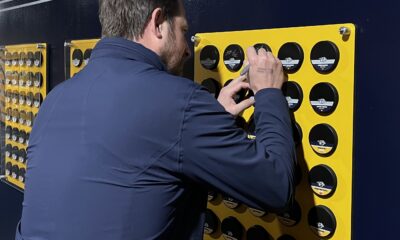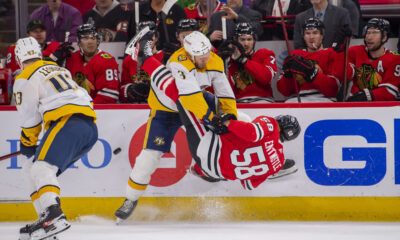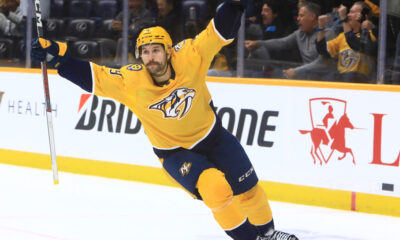 By mid-June, the Nashville Predators could rank in some pretty distinguished company when it comes to their scoring depth.
By mid-June, the Nashville Predators could rank in some pretty distinguished company when it comes to their scoring depth.
The Predators finished seventh in the NHL in total goals for, yet they don’t have a single top-20 goal scorer. Their top scorer, Viktor Arvidsson, finished tied for 33rd in the NHL in scoring with 29 goals.
So, how does that gel with the narrative that any potential Stanley Cup champion needs a “superstar” standout forward? As it turns out, teams like Nashville’s have won championships.
Since 1990, when dynasties no longer roamed the earth, three Stanley Cup championship teams have finished the regular season in the top 10 in team goals without a top-20 scorer: the 1993 Montreal Canadiens, the 1998 Detroit Red Wings and the 2011 Boston Bruins.
While all three of those teams were impressive on their own, the 1998 Red Wings stand out, having been voted the sixth-best NHL team of all time as part of the NHL’s Centennial celebration. It would be a stretch to try to equate this year’s Predators with one of the greatest NHL teams ever assembled, but if you look at the way these teams were built, the similarities are striking.
Speed, Skill, Scoring
Yzerman. Fedorov. Kozlov. Larionov. Fetisov. Shanahan.
All are enshrined in the Hockey Hall of Fame in Toronto, and all wore the winged wheel in 1998.
One of the greatest things about this Red Wings team was its ability to find the scoring touch from just about everybody. Each line they rolled out could jump on top of you and put one in the back of the net before you knew what hit you. Their leading scorer was Brendan Shanahan, who had 28 goals and finished 26th in the league in that category.
Now compare those Red Wings with these Predators. The Red Wings had 11 players score 10 or more goals. The Nashville Predators boast 13 players with 10 or more goals.
This is not to say that a team anchored by center Ryan Johansen should be in the same category as a team anchored by the great Steve Yzerman, but those similarities bode well for this Predators team that won the Presidents’ Trophy in 2018.
CBS Sports NFL writer Jason La Canfora covered the 1998 Red Wings for the Detroit Free Press, and he recalled how special that team was, led by coach Scotty Bowman.
“When that cast was fully assembled, there was certain things you had to do, and if you did them well, you knew Scotty was going to put you in a position to succeed,” La Canfora said. “And if you didn’t get it done, the next line might. Everybody, and especially that second season after they won the first Cup, I don’t want to say it was pre-ordained, but there was a sense.
“I do think they’re a bit of a unicorn in that regard. It’s a cliché, but it really was kind of a different hero every night.”
The Active Defense
In today’s NHL, active two-way defensemen are your key to dominance in both zones on the ice and therefore dominance of each round. These Red Wings were graced with the presence of one of the greatest defensemen ever: Nicklas Lidstrom.
Lidstrom was their top-scoring defenseman that season, scoring 15 goals and adding 42 assists. In the playoffs, he finished tied for third on the team in points with 19 as they dominated the Western Conference and swept the Washington Capitals in the Stanley Cup Final.
However, he wasn’t the only one contributing. Two of the Red Wings’ defenseman finished with 10 or more goals: Lidstrom and Larry Murphy, another future Hall of Famer. According to La Canfora, those two activated the rush in a dynamic way.
“They got a lot of scoring from defense as well,” he said. “Nick Lidstrom just created so much from the back line. He was so smooth. Larry Murphy was nearing the end, but was still a tremendous passer of the puck and could just unleash 40-foot tape-to-tape passes that would transition you into offense. The breakouts were so smooth. They had a lot going on.”
Sound familiar?
This season’s Predators feature three defensemen with 10 or more goals: P.K. Subban, Roman Josi and Mattias Ekholm. Defenseman Ryan Ellis might have had 10 goals if hadn’t missed extended time due to injury at the start of the season. Those four blue liners rank in a league of their own for jumping into the offensive zone and shutting down top lines at the other end.
Whether any of the Predators’ defensemen are hall of famers remains to be seen, but their ability to chip in all over the ice bears a striking similarity to the ’98 Red Wings.
Sandpaper
Having a team full of speed can win you a lot of hockey games and can score you a lot of goals. However, in the process, your players are going to get knocked around once in awhile.
That’s why you need guys that can take a hit and dole them out on your team. Those Red Wings and these Predators have those guys. For the 1998 Red Wings, their checking line was one of the greatest in NHL history: Darren McCarty, Kirk Maltby and Kris Draper.
The nature of that line was its ability to set the tempo and deliver bone-crunching hits. However, they weren’t simultaneously a liability.
“Those guys could score ugly goals,” La Canfora said. “They could set a tempo. Sometimes, they started games at times if Scotty just wanted to provide sort of energy or tempo. It was a pretty amazing team.”
The Predators’ checking line might actually be an improvement on the Red Wings model. Austin Watson, Miikka Salomaki and Mike Fisher are “sandpaper” players, but they can do more than score “ugly” goals. Watson has scored four shorthanded goals and plenty of goals that would be considered “goal-scorers” goals.
Backstopping
 Goaltending is another aspect in which the Predators actually might be able to one-up the champion Red Wings.
Goaltending is another aspect in which the Predators actually might be able to one-up the champion Red Wings.
Detroit’s goalie that season was Chris Osgood, who took over the starting job from Mike Vernon after the veteran was traded to the San Jose Sharks prior to the season. It’s extremely difficult to capture the Cup without a consistent goaltender as your last line of defense.
That wasn’t necessarily the case for Detroit in 1998. La Canfora said that there were issues with Osgood letting in soft goals, and that he struggled in their opening round matchup with the Phoenix Coyotes.
“Scotty stuck with him, and some people wondered if maybe he wouldn’t,” he said. “But he did, and Chris got better as the playoffs went on and it was a hell of team in front of him as well. I don’t remember that many times where he totally had to stand on his head and just win them games.”
As the NHL saw this season, Pekka Rinne could stand on his head and win games for the Predators. Rinne has had himself a Vezina-caliber year and is considered by many to be the frontrunner for the award (By comparison, Osgood finished seventh in Vezina Trophy voting in 1998).
During last year’s Stanley Cup Playoffs, Rinne frequently played lights-out. When he struggled, the team struggled. This season’s Rinne, who got plenty of rest down the stretch, looks like a game-changer. Like Osgood with the Red Wings, he may not need to be, but he can if needed.
Built for Greatness
For those Red Wings, Bowman was the mastermind that made the team work like a machine. Yzerman was the star that helped to carry out Bowman’s vision.
That was a pairing of legendary proportions.
“I just have a hard time comparing a lot of other teams to them,” La Canfora said. “Just because of how incredibly stout they were and how well-constructed they were, and then they also had this absolute freak of nature behind the bench who could literally flip a game with a line change. Just knowing when to double shift a guy and when to bury a guy in his bench and when to tweak a guy and when to rip a guy and when to make an example out of somebody.
“You just can’t discount Scotty Bowman’s experience and everything he went through with the Canadiens and his whole career arc. To have him being the guy pulling the strings 82 times a year with that collection of talent, that’s a special thing.”
The Predators have their own visionaries that can put the wheels in motion in David Poile and Peter Laviolette.
Since 2013, Poile has worked to construct this team in a way that will give it the best chance to win the Stanley Cup. He has brought in speed and depth. He planned out contracts strategically to give players term instead of the big immediate payday. In a sense, Bowman’s on-ice strategic vision is akin to Poile’s management vision.
Laviolette is one of Poile’s assets that gives this team the best chance to win. His system and the players have a symbiotic relationship. The players make the system work, and the system simultaneously fits the players perfectly. The genius of Poile has put this team in the best position possible to win the Cup this year, much like Bowman did for his players in 1998.
Who’s “The Guy?”
 The Predators blitzed through the regular season with few bumps in the road, and even the bumps in the road were minor relative to what other teams have gone through. They’ve done this on the backs of their unique, but clearly not unprecedented depth.
The Predators blitzed through the regular season with few bumps in the road, and even the bumps in the road were minor relative to what other teams have gone through. They’ve done this on the backs of their unique, but clearly not unprecedented depth.
However, once the playoffs get underway and every game, shift and play is magnified in its importance, the “strength in numbers” approach can fall short.
“That ‘by committee’ stuff is awesome over 82, but there’s going to have to be some people who take games over,” La Canfora said. “If you’re winning a Stanley Cup, then you’re going to have to have 3-6 guys who all would get legitimate Conn Smythe consideration. Maybe there’s one who obviously is the guy, but you’re going to have a forward or two, a defenseman and a goalie, who all would be among the six or seven people considered for a Conn Smythe. Without that, it doesn’t work. It just doesn’t.”
That Red Wings team found many of those guys. In that playoff run, the Red Wings boasted the top four point-getters in the entire league in Yzerman, Fedorov, Lidstrom and Tomas Holmstrom. Yzerman stood out above all the rest with a whopping 24 points en route to the Conn Smythe.
When the puck drops on Thursday night for the first game of what the Predators hope is a long playoff run, what players on the team start to emerge as those guys that will lead them to the pinnacle? Perhaps it will be Filip Forsberg, who picked up 13 points in the final 10 games of the regular season. Maybe it will be Ryan Johansen, who had 13 points in 14 playoff games last season before being sidelined with a freak injury.
The Red Wings built their success on depth, but built their run on a select group of standouts. If the Predators want to be the fourth top-10 scoring team since 1990 to win it all with no top-20 goal scorers, they’re going to need some players to play like top-20 goal scorers.
















